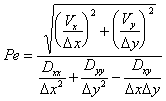The use of dimensionless variables for representing and
calculating stability criteria is common in groundwater modeling.
Dimensionless variables have the advantage of remaining
independent of time and space scales. This chapter presents
results as a function of three dimensionless variables; the
Peclet number (Pe), the Courant number (Co), and
the Damkohler number (Da).
The Peclet number relates the strength of advective forces
relative to dispersive forces in the simulation. The Peclet
number for a two-dimensional simulation is:
 |
(4.2) |
| Where: |
Vx,Vy
= pore water velocity in X and Y directions (L/T) |
| |
Dx = grid
spacing in the X direction (L) |
| |
Dy = grid
spacing in the Y direction (L) |
| |
Dxx = principal
dispersion coefficient in the X direction (L2/T) |
| |
Dyy = principal
dispersion coefficient in the Y direction (L2/T) |
| |
Dxy = cross dispersion
coefficient (L2/T) |
The Courant number relates to amount of advection relative to
the grid mesh size. The Courant number for a two-dimensional
simulation is:
 |
(4.3) |
| Where: |
Dt = time step
(T) |
| |
Vx,Vy
= pore water velocity in X and Y directions (L/T) |
| |
Dx = grid
spacing in the X direction (L) |
| |
Dy = grid
spacing in the Y direction (L) |
The Damkohler number relates the rate of solute decay to
advection. The Damkohler number in one dimension is:
 |
(4.4) |
| Where: |
k = first order decay rate (T-1) |
| |
D x = grid
spacing (L) |
| |
V = pore water velocity (L/T) |


